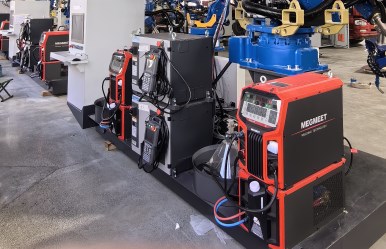In the realm of modern manufacturing, precision and accuracy are paramount. This holds especially true for industrial welding, a process where even the slightest miscalibration can lead to subpar results, safety hazards, and increased costs. As we venture into 2024, the importance of welding machine calibration remains as crucial as ever. This guide will walk you through the significance of calibrating welding machines, the step-by-step calibration procedure, and the updated calibration standards that define excellence in the welding industry.

I. Importance of Calibrating Welding Machine.
In the world of welding, precision is the key to success. Welding machine calibration is the foundation upon which this precision is built. The calibration process ensures that the welding machine functions at its optimal level, delivering consistent and accurate results. Here's why this process is so vital:
Precision and Quality: A calibrated welding machine guarantees precise control over parameters such as voltage, current, and wire feed speed. This precision directly translates into high-quality welds with consistent results, reducing the likelihood of defects and rework.
Safety: Welding involves high temperatures and electrical currents. Proper calibration ensures that your welding equipment operates within safe limits, minimizing the risk of accidents and ensuring the well-being of your welding personnel.
Compliance: Many industries have strict quality standards and regulations. Calibrating your welding machines helps you meet these requirements, ensuring that your products meet industry standards and pass inspections.
Cost Efficiency: Calibrated machines use resources efficiently, reducing wastage of materials and energy. It also helps extend the lifespan of your welding equipment, saving you money on repairs and replacements.
Consistency: In manufacturing, consistency is key. Calibrating your welding machines ensures that your welds remain consistent across different batches or projects, helping you build a reputation for reliable products.
II. Procedure of Welding Machine Calibration.
Calibrating a welding machine might sound complex, but it's a structured process that, when followed diligently, ensures reliable outcomes. Here's a step-by-step procedure for welding machine calibration:
Gather the Necessary Equipment: You'll need the right calibration equipment, including a calibrated multimeter, a clamp-on current probe, a wire feed speedometer, and a temperature measurement device.
Inspect the Machine: Before calibration, thoroughly inspect your welding machine for any visible damage or worn-out components. Make sure all connections are secure.
Verify Input Power: Ensure that the input power to the welding machine is stable and within the specified range. Fluctuations in input power can affect the welding parameters.
Voltage and Current Calibration: Use the multimeter to measure the output voltage and current while the machine is running. Compare the readings to the manufacturer's specifications. If there are discrepancies, adjust the machine's settings accordingly.
Wire Feed Speed Calibration: If your welding process involves a wire feeder, calibrate its speed to ensure the correct amount of wire is being fed. Improper wire feed speed can lead to inconsistent welds.
Gas Flow Rate: For processes that use shielding gas, check and calibrate the gas flow rate to ensure proper coverage and protection of the weld pool.
Temperature Monitoring: If your welding process involves temperature control, make sure the temperature measurement device is accurate and properly calibrated.
Document the Calibration: Keep a detailed record of the calibration process, including the initial readings, adjustments made, and final readings. This documentation is essential for quality control and compliance.
Regular Maintenance: Calibration isn't a one-time task. Establish a schedule for regular maintenance and calibration to ensure your welding machines remain in optimal condition.
III. Standard of Welding Machine Calibration
Significant changes have transpired in the realm of welding machine calibration standards in 2021. The previously applicable guidelines under BS EN 50504:2008 had been replaced by BS EN IEC 60974-14:2018. Now the market welding machine calibration is still BS EN IEC 60974-14:2018. Welding equipment not only must undergo calibration and validation, but it will also be subjected to a Machine Compliance Test (MCT), which serves as a critical electrical safety evaluation.
IV. How can Megmeet help with Welding Machine Calibration?
At Megmeet, we understand the importance of welding machine calibration and ensuring that your equipment operates in accordance with the latest industry standards. Building upon our dedication to delivering exceptional service, we're pleased to offer our expertise in calibration and validation.
Leveraging our industry expertise and years of knowledge, we offer personalized recommendations and advice, ensuring you select the right products within your budget and requirements. As industry professionals, we stand ready to support you and your business to achieve full calibration and validation for your welding machine. Reach out to Megmeet's friendly and knowledgeable staff today to explore how Megmeet can assist you.

In conclusion, the Welding Machine Calibration Guide for 2024 serves as an invaluable resource for welders and professionals in the industry. As technology continues to advance, ensuring the precision and accuracy of welding machines becomes increasingly essential. This guide not only highlights the importance of calibration but also provides a comprehensive step-by-step approach to calibrating various types of welding machines. By following these guidelines, welders can enhance their work quality, minimize defects, and improve overall safety in welding operations.
Related articles:
1. 5 Tips to Select a Suitable Welding Machine
2. Improve Your Productivity With Easy-To-Use Welding Machines
3. Top Inverter Welding Machine Brands in the World & How to Choose
4. Increase Productivity with Automatic TIG Welding Machines
5. Discover the Power of Megmeet Ehave-2 CM Welder Series: All-in-One Welding Machine





